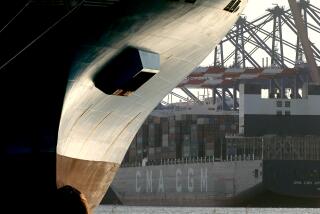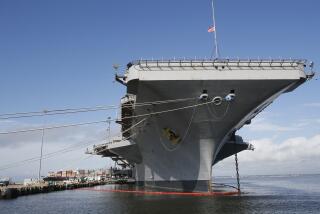Outlook Bleak for Nassco : Strike, Dwindling Contracts Plague Struggling Shipbuilder
- Share via
If privately-owned shipyards are measured by the number and size of the contracts that they get from the Navy, then the National Steel & Shipbuilding Co. is lagging far behind its major competitors.
According to Navy officials in Washington, Nassco has won only one new construction contract in the last three years. In January, 1987, the Navy awarded the shipyard a $290-million contract for the AOE, a fast combat support ship. The company began work on the contract in June, but the project ground to a temporary halt Wednesday when six of the seven unions at the yard went on strike.
Big Builder in 1970s
In the 1970s Nassco was a major builder of commercial ships, constructing 38 ships before companies began buying their ships from Korean and Japanese shipyards, where costs were lower and quality higher. Since 1980, the shipyard has depended mostly on Navy repair jobs for its survival. Besides the AOE contract, the only work currently under way at Nassco is a $60-million repair job that is scheduled to end in November.
A comparison of Nassco with the Avondale shipyard on the Gulf Coast and the Newport News yard in Virginia illustrates the shipyard’s woes. Avondale spokeswoman Rosemary James said last week that the New Orleans shipyard has won 10 new construction contracts from the Navy in the past year worth just under $2 billion. Jack Schnaedter, spokesman for the Newport News yard, said that the company has a $4.2 billion “backlog” of new construction and repair contracts from the Navy.
Series of Fines
In addition to dwindling contracts, Nassco has been plagued over the past three years by labor strife and a series of accidents that have resulted in hundreds of citations and thousands of dollars in fines levied by the federal Occupational Safety and Health Administration. Nassco has contested most of the citations and fines.
The seemingly endless line of problems has raised serious questions about Nassco’s ability to survive. The shipyard, once the largest on the West Coast, has gone from a peak employment of 7,600 workers in 1980 to about 2,000 workers today. In the past few years, representatives from shipyards on the East Coast have actively recruited skilled journeymen who have been laid off at Nassco.
“Nassco has gotten pretty obscure and is no longer actively followed,” said Walter Kircheberger, a Detroit-based analyst who follows the shipbuilding industry. “A shipyard is an expensive thing to have sitting there, if you don’t have any contracts and are losing money.”
Nassco, which used to be a major source of profits for its parent company, Morrison-Knudsen, reported $20 million in losses for the second quarter of 1988. Despite the shipyard’s bleak future and acknowledgment by Morrison-Knudsen officials that Nassco is in trouble, William Agee, newly appointed chairman and chief executive officer of Morrison-Knudsen, is reportedly committed to keeping Nassco in the conglomerate’s fold.
“Mr. Agee has said that Morrison-Knudsen as a corporation will continue to stand very solidly behind Nassco,” said Owen Dailey, spokesman for Agee.
But Agee’s show of support is contrasted by the pessimism expressed by Morrison-Knudsen officials in June, before Agee was picked to head the corporation, over Nassco’s chances to attract new work in the highly competitive shipbuilding and repair industry.
In a statement released on June 23, Morrison-Knudsen predicted continued problems for Nassco.
“Due in part to the unsettled environment created by ongoing craft union labor negotiations, procurement of additional repair business for the current year remains difficult . . . the low level of work in the shipyard is likely to produce operating losses until additional repair work and new ship construction contracts are obtained,” the statement said.
Cost Overruns
Union leaders charge that mismanagement by Nassco president Richard Vortmann and his team of managers is to blame for the shipyard’s financial problems. They point to the cost overruns incurred by the company on several Navy repair contracts.
Fred Hallett, Nassco vice president and spokesman, said that the company has failed to remain competitive because it is paying higher wages than those paid by shipyards, some of which are non-union, on the Gulf and East coasts.
In October, a few days after the company’s contract with the unions expired, Nassco unilaterally cut union wages 17% for skilled workers to more than 50% for unskilled laborers. The wage reductions brought a skilled worker’s wages down to $10.80 an hour, from $12.80. Unskilled workers were hit the hardest, going from $12.05 an hour to $5.55 an hour.
Hallett said that the cuts were necessary to bring wages paid by the shipyard closer in line to those paid on the Gulf and East coasts and make it easier for Nassco to obtain Navy contracts. But spokesmen for the Avondale and Newport News shipyards said that workers there are now earning more than the Nassco journeymen before they went on strike.
According to James, Avondale--a non-union yard where 60% of the stock is owned by employees--pays journeymen wages “in the neighborhood of $13 to $14” an hour to workers hired before April, 1987. The lowest-paid worker who was hired before April, 1987, earns about $9.50 an hour, James said.
Avondale has a two-tiered wage system for its 8,000 employees. Workers hired after April, 1987, make about $2 an hour less than those who started working at the shipyard before that date, James added.
‘Appalled’ at Cuts
Jerry Hufton, an official with the Ironworkers Union in Norfolk, Va., said that journeymen at the Newport News yard earn between $12 and $13 an hour. Hufton said he was “appalled” at the cuts imposed by Nassco, particularly those affecting unskilled workers.
“How in the world can you live on $5.55 an hour in California? The standard of living there is much higher than Virginia. How can a working man or woman afford to feed a family on those wages?” Hufton said.
On the day of the strike, Hallett repeated the company’s argument that wages had to be cut in order for the shipyard to remain competitive and in operation. Union leaders said that they will not agree to a new contract unless wages are increased to at least $12 an hour for journeymen, a proposal that Nassco has already rejected.
Both sides appear to be entrenched in their positions and it appears that the strike may be a long one.
“Nassco has made a commitment to try and stay in San Diego,” said Hallett. “Nassco had other options. We could have closed. We could have moved and gone someplace where they had lower labor costs and cost of living . . . . But we’ll try to get competitive wages and stay and fight.”
More to Read
Inside the business of entertainment
The Wide Shot brings you news, analysis and insights on everything from streaming wars to production — and what it all means for the future.
You may occasionally receive promotional content from the Los Angeles Times.










